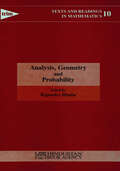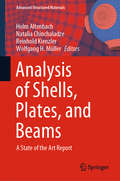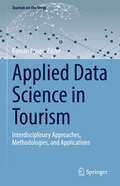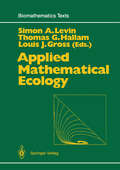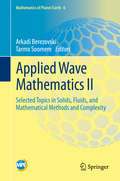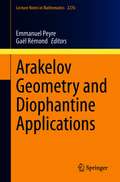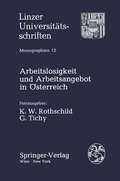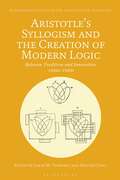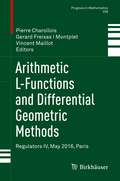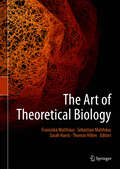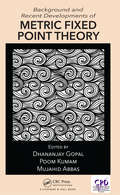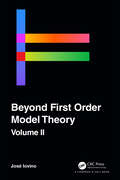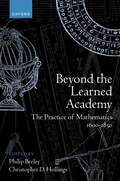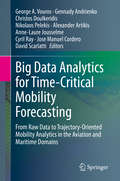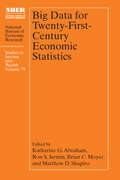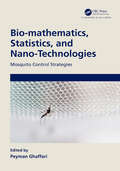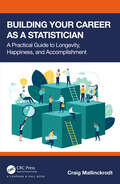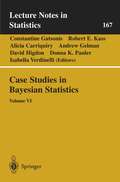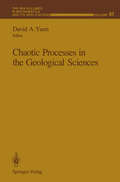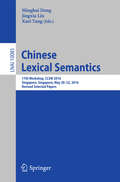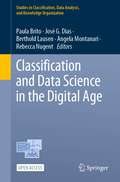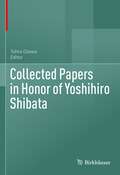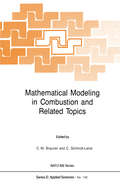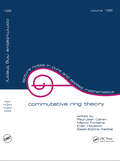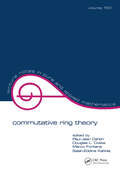- Table View
- List View
Analysis, Geometry and Probability: Essays in honour of K. R. Parthasarathy (Texts and Readings in Mathematics #10)
This book is a collection of expository articles by well-known mathematicians. Some of them introduce the reader to a major topic, while others provide a glimpse into an active field of research. All articles are accessible to graduate students. The articles were invited in honour of K. R. Parthasarathy, a mathematican, teacher and expositor of renown. Some of the articles, by his coworkers, are related to his work on probability, quantum probability and group representations. Others are on diverse topics in analysis, geometry and number theory.
Analysis of Shells, Plates, and Beams: A State of the Art Report (Advanced Structured Materials #134)
This book commemorates the 75th birthday of Prof. George Jaiani – Georgia’s leading expert on shell theory. He is also well known outside Georgia for his individual approach to shell theory research and as an organizer of meetings, conferences and schools in the field. The collection of papers presented includes articles by scientists from various countries discussing the state of the art and new trends in the theory of shells, plates, and beams. Chapter 20 is available open access under a Creative Commons Attribution 4.0 International License via link.springer.com.
Applied Data Science in Tourism: Interdisciplinary Approaches, Methodologies, and Applications (Tourism on the Verge)
Access to large data sets has led to a paradigm shift in the tourism research landscape. Big data is enabling a new form of knowledge gain, while at the same time shaking the epistemological foundations and requiring new methods and analysis approaches. It allows for interdisciplinary cooperation between computer sciences and social and economic sciences, and complements the traditional research approaches. This book provides a broad basis for the practical application of data science approaches such as machine learning, text mining, social network analysis, and many more, which are essential for interdisciplinary tourism research. Each method is presented in principle, viewed analytically, and its advantages and disadvantages are weighed up and typical fields of application are presented. The correct methodical application is presented with a "how-to" approach, together with code examples, allowing a wider reader base including researchers, practitioners, and students entering the field. The book is a very well-structured introduction to data science – not only in tourism – and its methodological foundations, accompanied by well-chosen practical cases. It underlines an important insight: data are only representations of reality, you need methodological skills and domain background to derive knowledge from them - Hannes Werthner, Vienna University of Technology Roman Egger has accomplished a difficult but necessary task: make clear how data science can practically support and foster travel and tourism research and applications. The book offers a well-taught collection of chapters giving a comprehensive and deep account of AI and data science for tourism - Francesco Ricci, Free University of Bozen-Bolzano This well-structured and easy-to-read book provides a comprehensive overview of data science in tourism. It contributes largely to the methodological repository beyond traditional methods. - Rob Law, University of Macau
Applied Mathematical Ecology (Biomathematics #18)
The Second Autumn Course on Mathematical Ecology was held at the Intern ational Centre for Theoretical Physics in Trieste, Italy in November and December of 1986. During the four year period that had elapsed since the First Autumn Course on Mathematical Ecology, sufficient progress had been made in applied mathemat ical ecology to merit tilting the balance maintained between theoretical aspects and applications in the 1982 Course toward applications. The course format, while similar to that of the first Autumn Course on Mathematical Ecology, consequently focused upon applications of mathematical ecology. Current areas of application are almost as diverse as the spectrum covered by ecology. The topiys of this book reflect this diversity and were chosen because of perceived interest and utility to developing countries. Topical lectures began with foundational material mostly derived from Math ematical Ecology: An Introduction (a compilation of the lectures of the 1982 course published by Springer-Verlag in this series, Volume 17) and, when possible, progressed to the frontiers of research. In addition to the course lectures, workshops were arranged for small groups to supplement and enhance the learning experience. Other perspectives were provided through presentations by course participants and speakers at the associated Research Conference. Many of the research papers are in a companion volume, Mathematical Ecology: Proceedings Trieste 1986, published by World Scientific Press in 1988. This book is structured primarily by application area. Part II provides an introduction to mathematical and statistical applications in resource management.
Applied Wave Mathematics II: Selected Topics in Solids, Fluids, and Mathematical Methods and Complexity (Mathematics of Planet Earth #6)
This book gathers contributions on various aspects of the theory and applications of linear and nonlinear waves and associated phenomena, as well as approaches developed in a global partnership of researchers with the national Centre of Excellence in Nonlinear Studies (CENS) at the Department of Cybernetics of Tallinn University of Technology in Estonia.The papers chiefly focus on the role of mathematics in the analysis of wave phenomena. They highlight the complexity of related topics concerning wave generation, propagation, transformation and impact in solids, gases, fluids and human tissues, while also sharing insights into selected mathematical methods for the analytical and numerical treatment of complex phenomena. In addition, the contributions derive advanced mathematical models, share innovative ideas on computing, and present novel applications for a number of research fields where both linear and nonlinear wave problems play an important role.The papers are written in a tutorial style, intended for non-specialist researchers and students. The authors first describe the basics of a problem that is currently of interest in the scientific community, discuss the state of the art in related research, and then share their own experiences in tackling the problem.Each chapter highlights the importance of applied mathematics for central issues in the study of waves and associated complex phenomena in different media. The topics range from basic principles of wave mechanics up to the mathematics of Planet Earth in the broadest sense, including contemporary challenges in the mathematics of society. In turn, the areas of application range from classic ocean wave mathematics to material science, and to human nerves and tissues. All contributions describe the approaches in a straightforward manner, making them ideal material for educational purposes, e.g. for courses, master class lectures, or seminar presentations.
Arakelov Geometry and Diophantine Applications (Lecture Notes in Mathematics #2276)
Bridging the gap between novice and expert, the aim of this book is to present in a self-contained way a number of striking examples of current diophantine problems to which Arakelov geometry has been or may be applied. Arakelov geometry can be seen as a link between algebraic geometry and diophantine geometry. Based on lectures from a summer school for graduate students, this volume consists of 12 different chapters, each written by a different author. The first chapters provide some background and introduction to the subject. These are followed by a presentation of different applications to arithmetic geometry. The final part describes the recent application of Arakelov geometry to Shimura varieties and the proof of an averaged version of Colmez's conjecture. This book thus blends initiation to fundamental tools of Arakelov geometry with original material corresponding to current research. This book will be particularly useful for graduate students and researchers interested in the connections between algebraic geometry and number theory. The prerequisites are some knowledge of number theory and algebraic geometry.
Arbeitslosigkeit und Arbeitsangebot in Österreich (Linzer Universitätsschriften #12)
Der vorliegende Band enthiilt die Referate und Koreferate, die im Oktober 1986 auf einem zweitllgigen Symposium Uber "Arbeitslosigkeit und Arbeits angebot in Osterreich" an der Universitiit Linz vorgetragen wurden. Die Be- trage basieren auf !aufenden Arbeiten und Zwischenergebnissen aus dem Fo- schungsschwerpunkt "Dynamik der Arbeitslosigkeit und Beschaftigung", einem auf fUnf Jahre geplanten Forschungsprogramm, das im Januar 1985 yom Fonds zur Forderung der wissenschaftlichen Forschung bewilligt und Mitte 1985 begonnen wurde. Das Projekt ist von dem Gedanken getragen, daB Fragen der Arbeitslosigkeit und Beschaftigung, die lange Zeit nieht sehr dringlich erschienen, nun intensiver Beachtung erfordem, da sie sich in allen Landem und nun auch in Osterreich als besonders hartnackiges Problem erweisen. 1m letzten Jahrzehnt hat die Arbeitsmarktforschung in Osterreich rasch an Umfang zugenommen, wobei vor allem Arbeiten aus dem Oste- reichischen Institut fUr Wirtschaftsforschung, dem Osterreichischen Statist- schen Zentralamt, dem Institut fUr Hohere Studien, dem Institut fUr Arbeit- marktpolitik an der Universitat Linz und okonomische und soziologische Untersuchungen an der Universitiit Graz zu erwahnen sind. Durch diese wissenschaftlichen Aktivitiiten, aber auch durch wichtige theoretische AnstoBe aus dem Ausland sowie durch eine wesentliche Ausweitung der yom Sozia- ministerium und den Arbeitsamtem zur VerfUgung gestellten Daten haben sich neue Moglichkeiten entwickelt, das Arbeitsmarktgeschehen in groBerem Detail zu analysieren. Wir sind dem Fonds zur Forderung der wissenschaf- lichen Forschung zu Dank verpflichtet, daB er durch Bewilligung des Schwe- punkts eine grUndliche Bearbeitung einiger dieser Themen ermoglicht hat.
Aristotle's Syllogism and the Creation of Modern Logic: Between Tradition and Innovation, 1820s-1930s (Bloomsbury Studies in the Aristotelian Tradition)
Offering a bold new vision on the history of modern logic, Lukas M. Verburgt and Matteo Cosci focus on the lasting impact of Aristotle's syllogism between the 1820s and 1930s. For over two millennia, deductive logic was the syllogism and syllogism was the yardstick of sound human reasoning. During the 19th century, this hegemony fell apart and logicians, including Boole, Frege and Peirce, took deductive logic far beyond its Aristotelian borders. However, contrary to common wisdom, reflections on syllogism were also instrumental to the creation of new logical developments, such as first-order logic and early set theory. This volume presents the period under discussion as one of both tradition and innovation, both continuity and discontinuity. Modern logic broke away from the syllogistic tradition, but without Aristotle's syllogism, modern logic would not have been born. A vital follow up to The Aftermath of Syllogism, this book traces the longue durée history of syllogism from Richard Whately's revival of formal logic in the 1820s through the work of David Hilbert and the Göttingen school up to the 1930s. Bringing together a group of major international experts, it sheds crucial new light on the emergence of modern logic and the roots of analytic philosophy in the 19th and early 20th centuries.
Arithmetic L-Functions and Differential Geometric Methods: Regulators IV, May 2016, Paris (Progress in Mathematics #338)
This book is an outgrowth of the conference “Regulators IV: An International Conference on Arithmetic L-functions and Differential Geometric Methods” that was held in Paris in May 2016. Gathering contributions by leading experts in the field ranging from original surveys to pure research articles, this volume provides comprehensive coverage of the front most developments in the field of regulator maps. Key topics covered are:• Additive polylogarithms• Analytic torsions• Chabauty-Kim theory• Local Grothendieck-Riemann-Roch theorems• Periods• Syntomic regulatorThe book contains contributions by M. Asakura, J. Balakrishnan, A. Besser, A. Best, F. Bianchi, O. Gregory, A. Langer, B. Lawrence, X. Ma, S. Müller, N. Otsubo, J. Raimbault, W. Raskin, D. Rössler, S. Shen, N. Triantafi llou, S. Ünver and J. Vonk.
The Art of Theoretical Biology
This beautifully crafted book collects images, which were created during the process of research in all fields of theoretical biology. Data analysis, numerical treatment of a model, or simulation results yield stunning images, which represent pieces of art just by themselves. The approach of the book is to present for each piece of visualization a lucid synopsis of the scientific background as well as an outline of the artistic vision.
Background and Recent Developments of Metric Fixed Point Theory
This book focusing on Metric fixed point theory is designed to provide an extensive understanding of the topic with the latest updates. It provides a good source of references, open questions and new approaches. While the book is principally addressed to graduate students, it is also intended to be useful to mathematicians, both pure and applied.
Beyond First Order Model Theory, Volume II
Model theory is the meta-mathematical study of the concept of mathematical truth. After Afred Tarski coined the term Theory of Models in the early 1950’s, it rapidly became one of the central most active branches of mathematical logic. In the last few decades, ideas that originated within model theory have provided powerful tools to solve problems in a variety of areas of classical mathematics, including algebra, combinatorics, geometry, number theory, and Banach space theory and operator theory. The two volumes of Beyond First Order Model Theory present the reader with a fairly comprehensive vista, rich in width and depth, of some of the most active areas of contemporary research in model theory beyond the realm of the classical first-order viewpoint. Each chapter is intended to serve both as an introduction to a current direction in model theory and as a presentation of results that are not available elsewhere. All the articles are written so that they can be studied independently of one another. This second volume contains introductions to real-valued logic and applications, abstract elementary classes and applications, interconnections between model theory and function spaces, nonstucture theory, and model theory of second-order logic. Features A coherent introduction to current trends in model theory. Contains articles by some of the most influential logicians of the last hundred years. No other publication brings these distinguished authors together. Suitable as a reference for advanced undergraduate, postgraduates, and researchers. Material presented in the book (e.g, abstract elementary classes, first-order logics with dependent sorts, and applications of infinitary logics in set theory) is not easily accessible in the current literature. The various chapters in the book can be studied independently.
Beyond the Learned Academy: The Practice of Mathematics, 1600-1850
The tremendous growth of the mathematical sciences in the early modern world was reflected contemporaneously in an increasingly sophisticated level of practical mathematics in fields such as merchants' accounts, instrument making, teaching, navigation, and gauging. In many ways, mathematics shaped the knowledge culture of the age, infiltrating workshops, dockyards, and warehouses, before extending through the factories of the Industrial Revolution to the trading companies and banks of the nineteenth century. While theoretical developments in the history of mathematics have been made the topic of numerous scholarly investigations, in many cases based around the work of key figures such as Descartes, Huygens, Leibniz, or Newton, practical mathematics, especially from the seventeenth century onwards, has been largely neglected. The present volume, comprising fifteen essays by leading authorities in the history of mathematics, seeks to fill this gap by exemplifying the richness, diversity, and breadth of mathematical practice from the seventeenth century through to the middle of the nineteenth century.
Big Data Analytics for Time-Critical Mobility Forecasting: From Raw Data to Trajectory-Oriented Mobility Analytics in the Aviation and Maritime Domains
This book provides detailed descriptions of big data solutions for activity detection and forecasting of very large numbers of moving entities spread across large geographical areas. It presents state-of-the-art methods for processing, managing, detecting and predicting trajectories and important events related to moving entities, together with advanced visual analytics methods, over multiple heterogeneous, voluminous, fluctuating and noisy data streams from moving entities, correlating them with data from archived data sources expressing e.g. entities’ characteristics, geographical information, mobility patterns, mobility regulations and intentional data. The book is divided into six parts: Part I discusses the motivation and background of mobility forecasting supported by trajectory-oriented analytics, and includes specific problems and challenges in the aviation (air-traffic management) and the maritime domains. Part II focuses on big data quality assessment and processing, and presents novel technologies suitable for mobility analytics components. Next, Part III describes solutions toward processing and managing big spatio-temporal data, particularly enriching data streams and integrating streamed and archival data to provide coherent views of mobility, and storing of integrated mobility data in large distributed knowledge graphs for efficient query-answering. Part IV focuses on mobility analytics methods exploiting (online) processed, synopsized and enriched data streams as well as (offline) integrated, archived mobility data, and highlights future location and trajectory prediction methods, distinguishing between short-term and more challenging long-term predictions. Part V examines how methods addressing data management, data processing and mobility analytics are integrated in big data architectures with distinctive characteristics compared to other known big data paradigmatic architectures. Lastly, Part VI covers important ethical issues that research on mobility analytics should address. Providing novel approaches and methodologies related to mobility detection and forecasting needs based on big data exploration, processing, storage, and analysis, this book will appeal to computer scientists and stakeholders in various application domains.
Big Data for Twenty-First-Century Economic Statistics (National Bureau of Economic Research Studies in Income and Wealth #79)
The papers in this volume analyze the deployment of Big Data to solve both existing and novel challenges in economic measurement. The existing infrastructure for the production of key economic statistics relies heavily on data collected through sample surveys and periodic censuses, together with administrative records generated in connection with tax administration. The increasing difficulty of obtaining survey and census responses threatens the viability of existing data collection approaches. The growing availability of new sources of Big Data—such as scanner data on purchases, credit card transaction records, payroll information, and prices of various goods scraped from the websites of online sellers—has changed the data landscape. These new sources of data hold the promise of allowing the statistical agencies to produce more accurate, more disaggregated, and more timely economic data to meet the needs of policymakers and other data users. This volume documents progress made toward that goal and the challenges to be overcome to realize the full potential of Big Data in the production of economic statistics. It describes the deployment of Big Data to solve both existing and novel challenges in economic measurement, and it will be of interest to statistical agency staff, academic researchers, and serious users of economic statistics.
Bio-mathematics, Statistics, and Nano-Technologies: Mosquito Control Strategies
Finding effective methods for mosquito control remains one of the great global challenges facing this generation. Bio-mathematics, Statistics and Nano-Technologies: Mosquito Control Strategies brings together experts from a large array of disciplines in order to provide a comprehensive overview of cutting-edge techniques to model, analyse and combat mosquito-transmitted vector-borne diseases. Features Includes multiple case studies Suitable for scientists and professionals working on methods for mosquito control and Epidemiology Provide a much-needed focal point for interdisciplinary discussion
Building Your Career as a Statistician: A Practical Guide to Longevity, Happiness, and Accomplishment
This book is intended for anyone who is considering a career in statistics or a related field, or those at any point in their career with sufficient work time remaining such that investing in additional learning could be beneficial. As such, the book would be suitable for anyone pursing an MS or PhD in statistics or those already working in statistics. The book focuses on the non-statistical aspects of being a statistician that are crucial for success. These factors include 1) productivity and prioritization, 2) innovation and creativity, 3) communication, 4) critical thinking and decisions under uncertainty, 5) influence and leadership, 6) working relationships, and 7) career planning and continued learning. Each of these chapters includes sections on foundational principles and a section on putting those principles into practice. Connections between these individual skills are emphasized such that the reader can appreciate how the skills build upon each other leading to a whole that is greater than the sum of its parts. By including the individual perspectives from other experts on the fundamental principles and their application, readers will have a well-rounded view on how to build upon and fully leverage their technical skills in statistics. The primary audience for the book is large and diverse. It will be useful for self-study by virtually any statistician, but could also be used as a text in a graduate program that includes a course on careers and career development.Key Features: Takes principles proven to be useful in other settings and applies them to statisticians and statistical settings. Focused Concise Accessible to all levels, from grad students to mid-later career statisticians.
Case Studies in Bayesian Statistics: Volume VI (Lecture Notes in Statistics #167)
This volume contains invited case studies with the accompanying discussion as well as contributed papers selected by a refereeing process of 6th Workshop on Case Studies in Bayesian Statistics was held at the Carnegie Mellon University in October, 2001.
Chaotic Processes in the Geological Sciences (The IMA Volumes in Mathematics and its Applications #41)
This IMA Volume in Mathematics and its Applications CHAOTIC PROCESSES IN THE GEOLOGICAL SCIENCES is based on the proceedings of a workshop which was an integral part of the 1989- 90 IMA program on "Dynamical Systems and their Applications". The workshop was intended to be an arena for scientific exchanges between earth scientists and mathematical researchers, especially with experts in dynamical systems. We thank Shui-Nee Chow, Martin Golubitsky, Richard McGehee, George R. Sell and David Yuen for organizing the meeting. We especially thank David Yuen for editing the proceedings. We also take this opportunity to thank those agencies whose financial support made the workshop possible: the Army Research Office, the Minnesota Supercomputer Institute, the National Science Foundation, and the Office of Naval Research. A vner Friedman Willard Miller, Jr. PREFACE The problems in geological sciences have many nonlinearities from the nature of the complicated physical laws which give rise to strongly chaotic behavior. Foremost and most visible are earthquakes and volcanic eruptions, more subtle are the time dependent variations of the Earth's magnetic fields and motions of the surface plates.
Chinese Lexical Semantics: 17th Workshop, CLSW 2016, Singapore, Singapore, May 20–22, 2016, Revised Selected Papers (Lecture Notes in Computer Science #10085)
This book constitutes the thoroughly refereed post-workshop proceedings of the 17th Chinese Lexical Semantics Workshop, CLSW 2016, held in Singapore, Singapore, in May 2016. The 70 regular papers included in this volume were carefully reviewed and selected from 182 submissions. They are organized in topical sections named: lexicon and morphology, the syntax-semantics interface, corpus and resource, natural language processing, case study of lexical semantics, extended study and application.
Classification and Data Science in the Digital Age (Studies in Classification, Data Analysis, and Knowledge Organization)
The contributions gathered in this open access book focus on modern methods for data science and classification and present a series of real-world applications. Numerous research topics are covered, ranging from statistical inference and modeling to clustering and dimension reduction, from functional data analysis to time series analysis, and network analysis. The applications reflect new analyses in a variety of fields, including medicine, marketing, genetics, engineering, and education.The book comprises selected and peer-reviewed papers presented at the 17th Conference of the International Federation of Classification Societies (IFCS 2022), held in Porto, Portugal, July 19–23, 2022. The IFCS federates the classification societies and the IFCS biennial conference brings together researchers and stakeholders in the areas of Data Science, Classification, and Machine Learning. It provides a forum for presenting high-quality theoretical and applied works, and promoting and fostering interdisciplinary research and international cooperation. The intended audience is researchers and practitioners who seek the latest developments and applications in the field of data science and classification.
Collected Papers in Honor of Yoshihiro Shibata
Yoshihiro Shibata has made many significant contributions to the area of mathematical fluid mechanics over the course of his illustrious career, including landmark work on the Navier-Stokes equations. The papers collected here — on the occasion of his 70th birthday — are written by world-renowned researchers and celebrate his decades of outstanding achievements.
Commutative Algebra: Proceedings of a Microprogram Held June 15–July 2, 1987 (Mathematical Sciences Research Institute Publications #15)
During late June and early July of 1987 a three week program (dubbed "microprogram") in Commutative Algebra was held at the Mathematical Sciences Research Institute at Berkeley. The intent of the microprogram was to survey recent major results and current trends in the theory of commutative rings, especially commutative Noetherian rings. There was enthusiastic international participation. The papers in this volume, some of which are expository, some strictly research, and some a combination, reflect the intent of the program. They give a cross-section of what is happening now in this area. Nearly all of the manuscripts were solicited from the speakers at the conference, and in most instances the manuscript is based on the conference lecture. The editors hope that they will be of interest and of use both to experts and neophytes in the field. The editors would like to express their appreciation to the director of MSRI, Professor Irving Kaplansky, who first suggested the possibility of such a conference and made the task of organization painless. We would also like to thank the IVISRI staff who were unfailingly efficient, pleasant, and helpful during the meeting, and the manager of MSRI, Arlene Baxter, for her help with this volume. Finally we would like to express our appreciation to David Mostardi who did much of the typing and put the electronic pieces together.
Commutative Ring Theory: Proceedings of the Ii International Conference
Presents the proceedings of the Second International Conference on Commutative Ring Theory in Fes, Morocco. The text details developments in commutative algebra, highlighting the theory of rings and ideals. It explores commutative algebra's connections with and applications to topological algebra and algebraic geometry.
Commutative Ring Theory
" Exploring commutative algebra's connections with and applications to topological algebra and algebraic geometry, Commutative Ring Theory covers the spectra of rings chain conditions, dimension theory, and Jaffard rings fiber products group rings, semigroup rings, and graded rings class groups linear groups integer-valued polynomials rings of finite fractions big Cohen-Macaulay modules and much more!"
